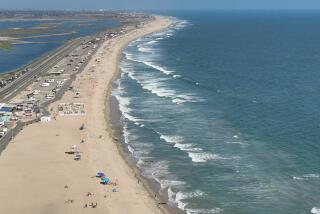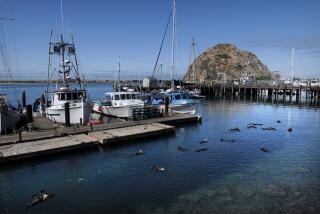Panel Extends Swimming Ban
AVILA BEACH, Calif. — The Port San Luis Harbor Commission voted to extend the ban on swimming in the waters off Avila Beach until Friday as part of a new policy adopted after a shark was sighted in the same waters where a 50-year-old swimmer was attacked and killed last week.
The decision Tuesday night to extend the closure was made as officials grappled with the idea of when to reopen the beaches after the death of Deborah Blanche Franzman, who was killed Aug. 19 by a 15- to 18-foot great white shark.
“Nobody can ever say it is absolutely safe to go back in the water. We are not proclaiming that,” said Casey Nielsen, operations manager for the port district. “We are only doing the five-day limit to give us a cooling-off period and an education period.”
The beaches at Avila were closed immediately after the attack on Franzman -- the 10th killing by a great white shark off the California coast since record keeping began in the early 1950s.
The waters off Avila Beach reopened Thursday, but were closed again Saturday after anchovy bait fishermen saw a great white shark attack a seal 400 yards off shore in the same vicinity.
The waters will reopen again Friday morning in time for the Labor Day weekend, with signs advising visitors to swim at their own risk, Nielsen said.
The new harbor district policy bans ocean swimming for five days after a shark attack or sighting. It also authorizes officials to close the waters when a seal or sea lion carcass is found on the beach with wounds from a great white shark.
Other beach authorities in San Luis Obispo County are reviewing how to deal with shark sightings, although some prefer a joint effort instead of acting alone. Before last week’s fatal attack, a multi-agency Ocean Incident Response Group was formed representing all the beach agencies in the county, but it is still working on a strategy to handle shark incidents.
Pismo Beach Mayor Joe Crescione wants cooperation.
“Now that we have this kind of warning, this knowledge that there is a large fish out there that can hurt people, it seems really proper to do something about protecting the citizens who come here,” Crescione said. He expects the Pismo Beach City Council to tackle the issue soon.
Further up the coast, the Golden Gate National Recreational Area and the Point Reyes National Seashore north of San Francisco also impose short-term water closures if sharks have been active in the area. Stinson’s Beach in particular has had occasional nonfatal shark attacks.
Marine biologists familiar with sharks say there is no way to predict what a shark will do.
“These animals have occurred off the coast of California for tens of thousands of years,” said Robert Lea, a shark expert with the California Department of Fish and Game. “What’s changed is how we go in the ocean and use the ocean. They haven’t changed.”
Douglas Long, an expert on the marine mammals eaten by white sharks, said that only 100 or so great white sharks are believed to live off the California coast.
Steve Capps, spokesman for the California State Parks Department, which controls much of the coastline in San Luis Obispo County, including Pismo State Beach, said his agency put up signs about the attack, as other beaches did.
Some in Avila fear that closing the beach to swimming will have a negative effect on businesses. But they also emphasize that it’s impossible to isolate the public’s concern over the shark attack from the naturally slowing seasonal business.
As the summer season winds down, the community puts on events to attract visitors. This weekend, the Avila Beach Golf Resort is hosting a concert by reggae artist Jimmy Cliff on Saturday and a San Luis Obispo Symphony pops concert on Sunday.
“That’s when we’ll see local people come back to Avila,” said Steve Goodale, general manager of the Old Custom House restaurant.
More to Read
Sign up for Essential California
The most important California stories and recommendations in your inbox every morning.
You may occasionally receive promotional content from the Los Angeles Times.










